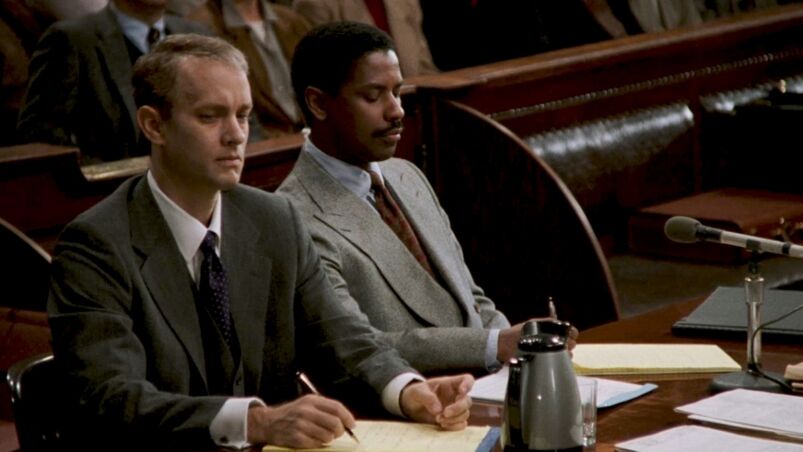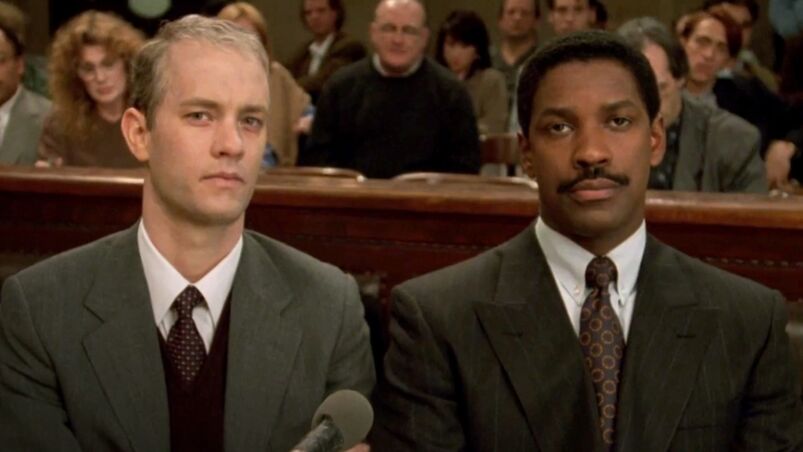
Welcome back to our queer film retrospective, “A Gay Old Time.” In this week’s column, we revisit 1993’s Philadelphia in celebration of the film’s 30th anniversary.
This month marks the 30th anniversary of Philadelphia, Jonathan Demme’s groundbreaking legal drama starring Tom Hanks and Denzel Washington. The movie—scripted by Fellow Travelers creator Ron Nyswaner—centers on a man wrongfully fired because he has AIDS, and his attempts to sue his workplace with the help of a homophobic small-town lawyer.
Released in the shadow of the AIDS epidemic, the movie was met with critical acclaim, earning Hanks his first Oscar for Best Actor, as well as an undeniable place in queer cinema history.
This week, we take a look back at the film with three decades of distance, and hundreds of miles ahead in regards to our community’s (and the world’s) position towards HIV/ AIDS. How does a movie that centers a gay man—but very much positions him in a mostly straight and heavily prejudiced world—feel this time around? What are its merits, what still holds up, and where are some areas where the film feels like a product of its time—or perhaps have always felt a bit out of step?
The Set Up
Philadelphia follows Andrew “Andy” Beckett (Tom Hanks), a hard-working lawyer in one of the city’s largest firms, who has just been assigned a very important case that ensures his future there. He’s been living with AIDS for an undisclosed amount of time, with the support of his partner Miguel (Antonio Banderas). But, after one of the law partners notices a lesion on his face, Andy is fired under the pretense of mishandling the case.
However, Andy’s certain that he was fired for his illness, turning to Joseph “Joe” Miller (Denzel Washington), a prejudiced lawyer that nevertheless believes in the prevalence of the law. Together, they embark in a legal battle against the law firm, who tries to disprove Andy’s testimony, as he slowly begins to succumb the disease.
Shedding Light On A Dark Time
The movie does a valiant and surprisingly three-dimensional job of portraying AIDS and those living with it as people worthy of dignity, love, humanity, and compassion. Jonathan Demme’s signature style of capturing his actors’ performances in tight close-ups is utilized beautifully and creates moments of intimacy, fear, and claustrophobia as Andy’s world starts to slowly crumble.
Every frame is filled with empathy for its characters, with Andy clearly positioned as the hero of the story that we should sympathize and root for. The film is a purposeful attempt to bring light to AIDS, and destigmatize all assumptions and prejudices associated with it, as well as the gay community overall.
It even manages to subvert some expectations that one would expect from this kind of narrative during that time period. When the movie begins, Andy has already received his AIDS diagnosis and is living with and managing it. We don’t see the incident in which he contracts it, or the moments where he has to break down the news to his partner or his family. It’s just another element of his life that he has already accepted and integrated.
His family knows of his sexuality, his romantic relationship, and his disease, and are surprisingly accepting of them all, voicing their total support when he tells him things may get ugly during the trial. That unconditional support may not have been the norm at the time, or the most realistic depiction of what the life of a man living with AIDS might have looked like, but given the ups and downs that the story navigates, it’s refreshing (and in many ways, relieving) to see that at least those elements of his life are not bound to end in tragedy.
Two Times The Star Power

But what perhaps makes the movie most radical and groundbreaking for its time is not necessarily its handling or reframing of LGBTQ+ and HIV narratives, rather the way it uses the two acclaimed actors at the center to tell the story.
Tom Hanks and Denzel Washington were perhaps two of the biggest names in movies in 1993, at a time where the mere presence of a big star was enough to drive people to the theaters. Attaching themselves to this project meant that millions of people would go watch a story about a subject that made them uncomfortable and challenge their own beliefs. And it most likely could have meant career suicide for them. But having their names increased the film’s legitimacy, and thus its outreach with audiences.
Related:
These are the Top 10 highest-grossing LGBTQ+ films of all time—but how gay are they, really?
Some of the films on this list are unquestionably queer classics, and others? Well… not so much.
Queer Guy For The Straight Eye
However, even with all the care and empathy that is put on by both the filmmakers and the actors, and with a gay man’s experience at the center of the story, Philadelphia is still very much a movie made for straight audiences and their sensibilities. Although Andy is the protagonist, the POV into the story and the audience surrogate is very much Denzel Washington, whose arc goes from literally not wanting to touch Andy, to accompanying him on his deathbed.
Yes, the film helped shift the broader public’s understanding of AIDS in a way that was groundbreaking (and undoubtedly helpful) for the time, but it doesn’t really do so from the gay perspective.
In this movie, Andy is a gay man living in and for a straight world, when HIV/AIDS was much more deeply ingrained into the crevices of the gay community. It was a period of time where community meant refuge, and knowledge, pain, and joy in equal measure. The movie services and absolves its straight characters (and audiences), but strips away the inherently queer roots and repercussions of AIDS.
Milestone Moviemaking

It’s of course easier to see this in hindsight. Especially when a lot of the stigma and complications have changed radically since then, in no small part thanks to movies and stories like this one, where established filmmakers and stars dared to take a big leap away from mainstream assumptions. So Philadelphia is an artifact in more ways than one; both as a testament of how a film could play a large role in reframing prejudice and stigma, but also how they often don’t even take into account the perspective of those prejudiced and stigmatized. So much has changed since then. And at the same time, so little.
Related:
‘Fellow Travelers’ creator Ron Nyswaner on gay life in the ’60s & ’70s, why AIDS stories still matter & more
On World AIDS Day 2023, the ‘Philadelphia’ screenwriter reflects on his trailblazing film, 30 years later, and his full-circle moment with ‘Fellow Travelers.’





















KissBananaPeels
For its time it did the job but if it was going to happen today…the film makers would have to make the a Black gay man of whom this story is based on:
The case unfolded in Philadelphia in 1990 in a real courtroom, not a movie set. It was one of the lawsuits studied by the makers of “Philadelphia,” which opened here this month. Like the film’s Tom Hanks character, Clarence Cain, 37, was a funny, bright, successful lawyer who won a discrimination case against his employers before he lost to the disease.
Yes, that is right…racism won out…NOT the truth and surely NOT Black gay males representation during the AIDS crisis
Kangol2
We both know there was no way Hollywood was going to make a movie about that Black gay man at the center of this story back in 1990. Not. Going. To. Happen. That was the era of the New Black Cinema, with so many talented young and developing (from the 1970s) Black directors, and most had to battle tooth and nail to make their films, even when, as was the case with Spike Lee, they met with considerable success. Would Hollywood make a film about Clarence Cain today? With the right screenwriters and director and probably unknown amounts of struggle to convince backers, it just might happen.
Fname Optional Lname
Sorry but Tom Hanks had no business making this movie. I’m sure in his mind he was helping the cause but it’s just insulting.
Man About Town
I remember intensely disliking this film when it came out, though I suppose it served a much-needed purpose.
I didn’t believe for a minute the relationship between Tom Hanks and Antonio Banderas.
I hated the stilted scene where, after Tom announces to his family that he’s considering a lawsuit, the video camera goes around to each famiy member giving their opinions. I didn’t realize I was watching a home movie!
And the excrutiatingly long scene where he dances with his IV connection to an opera piece made me long for either some aspirin or a long nap.
I agreed with Larry Kramer who said it was “an achingly mediocre movie.”
And Ron Nyswaner wrote a much better screenplay for the vastly underrated “Mrs. Soffel.”
Jim
I rewatched it a few weeks ago.
I realized when I first watched it my (and probably everyone else) was focused on Andy and his story.
The second time I noticed Joe’s story too.
Rewatch it if just for that .